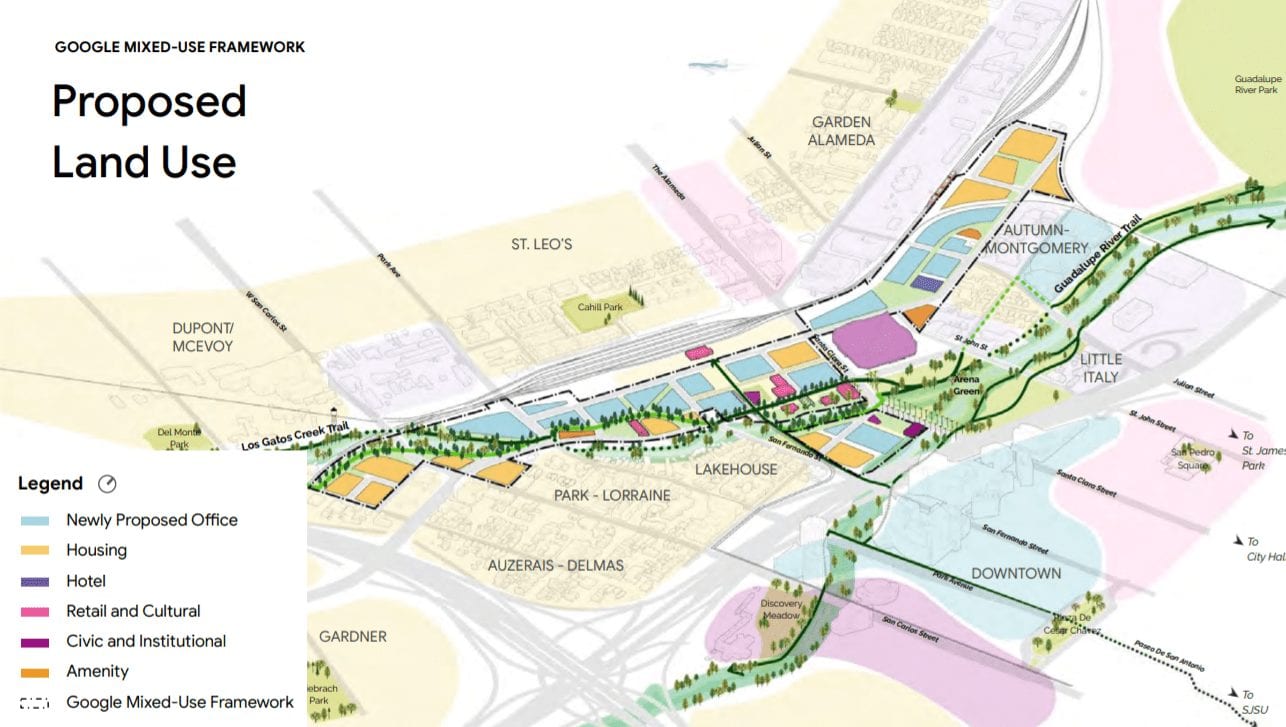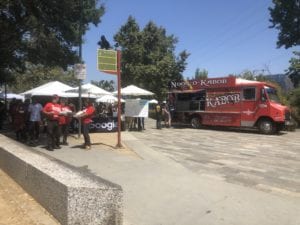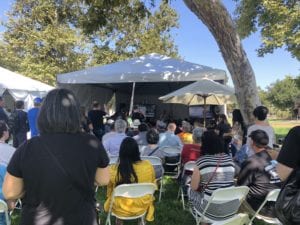Hundreds of South Bay residents on Saturday got a glimpse of a future that includes Google in San Jose’s downtown core during the tech giant’s first community meeting since unveiling its vision for a massive new campus near Diridon Station.
Food trucks dotted the Arena Green West park offering free lunches while children ran around with painted faces and people at a pop-up stand handed out flowers made from balloons — a preview, perhaps, of what could become of the area in a couple years if Google gets the approvals to move forward.
The Mountain View-based company on Thursday unveiled plans to build about 6.5 million square feet of office space on a sprawling campus with thousands of residential units, approximately 500,000 square feet of retail, hotel, cultural and arts space and 15 acres of park land and greenery. That’s the most detailed view offered to date of the project set to rise at least in part on land once slated to become a baseball stadium for the Oakland A’s.
Its unveiling drew plenty of attention.
“When I walked over here I was just amazed at the community turnout,” said Jonathan Martinez, a San Jose resident and member of the city’s Station Area Advisory Group, which is working to reevaluate the zoning and development plan for the area around Diridon Station. “Other ones (meetings) have been small and haven’t had as much of a turnout, but this is amazing.”


Google representatives in two white tents offered details about the company’s development framework for a more than 8 million-square-foot campus they hope to build on 60 acres around Diridon Station. In one tent, Google employees stood next to poster boards filled with information about the planned project.
In another, company leaders and its urban design consultant SiteLab offered a guided presentation that outlined plans for a sprawling campus with tall office buildings, dotted with parks, plazas, apartment buildings and punctuated by cultural and art corridors.
It was the second time in three days Google leaders gave the presentation, but the vibe in the sunny park Saturday was dramatically different than the first meeting, held Thursday at City Hall.
During that City Hall meeting, some community members protested, halting the presentation a few times when their frustrations boiled over. Some community members said they were excited for the project, but many others wondered aloud to Google and city leaders if they’d be able to afford to live in San Jose after Google made its formal entrance into downtown.
But on Saturday, there were no protests, and residents wrote their thoughts on sticky notes pinned to poster boards, mostly proclaiming enthusiasm for the project, offering suggestions for the tech titan and asking questions.
“The excitement was powerful because it is an exciting plan and it is also a generous plan,” said Scott Knies, executive director for the San Jose Downtown Association. “It is generous with San Jose with the open space and with the … spaces for artists. Nobody else would be leading with that.”
Indeed, several residents said the plazas and open space was what excited them most.
“We walk downtown a lot and being able to walk among the parks and different plazas and things instead of going through buildings is just really exciting to us,” said Shirley Bell, a downtown resident.


Community concerns
Some residents on Saturday had concerns too, including questions about housing, which was front-of-mind for many.
Google has released few details so far about exactly how many homes would sprout throughout the campus and how many of those would be considered affordable.
“We’ll hear more specificity on that as we go into the spring,” Alexa Arenas, Google’s director of real estate development, promised a crowd of a couple hundred Saturday morning. “We’re not quite there yet which is pretty natural for where we are in the process.”
The current specific plan for the Diridon Station area calls for around 2,800 homes and Google wants to see a minimum of 3,000 — but potentially as many as 5,000 homes — built on its land, which accounts for about one-third of the Diridon Station area.


The company has partnered with international developer Lendlease to build nearly everything but the office space in most of its mixed-use developments in the Bay Area, including in San Jose, Sunnyvale and Mountain View.
Google also announced a $1 billion housing commitment earlier this year aimed at jumpstarting local affordable housing projects in the near-term, though some details about how the investment will be deployed remain fuzzy.
Bell, the downtown resident, said her major concern is parking. Google’s vision leans heavily on the idea that residents and workers will take transit and walk to work downtown.
“I understand the concept of people wanting to live and work in downtown, and that works for us because we walk all over, but we also have to leave downtown and how would we go?” Bell said. “My concern for that .4 (parking spots per unit) reduced parking criteria is that it could negatively impact people’s quality of life.”
Martinez is worried about the potential pushback to building heights in the development. San Jose city leaders recently raised the height limits for buildings in downtown and around Diridon Station, which adds up to 8.6 million square feet in development potential in the area.
“We need to be able to go higher and people are going to have to be able to accept that as a way of life here in San Jose,” he said. “This is a big city now, so the transit hubs around the BART stations need to be twice as high as what they are thinking.”


Google hasn’t said how high its buildings will rise — those details will likely become more clear when the company submits its formal application to the city in October. But project leaders have said Google plans to take advantage of the increased height limits.
And as Google works out those types of details of its plan and the community benefits package that will come with a future development agreement with the city, the company is also continuing to work out other key, but complex, details around the project.
Chief among them is whether the Alphabet Inc.-owned company will strike a deal to buy a set of parking lots near the SAP Center that provide parking for hockey fans when the San Jose Sharks play at the arena.
The Sharks have a contract with the city of San Jose to ensure parking in close proximity to the arena. Google will need to work out a deal with the sports team before it can purchase three key parking lots in the middle of its path of development — a negotiation that city leaders have conceded will be complicated.
San Jose’s City Council is expected to vote on Google’s formal project proposal by Fall 2020 and Google representatives said they’ll continue to host community input events between now and then. City leaders say the community engagement now is key.
“Most development throughout the city will be piecemeal,” Downtown San Jose Councilmember Raul Peralez told attendees Saturday. “We may plan out large areas, but as development comes in, it comes in really one at a time. … But we have an opportunity here to help design, provide input and create an entire area.”
Contact Janice Bitters at [email protected] or follow @JaniceBitters on Twitter.



Leave a Reply
You must be logged in to post a comment.